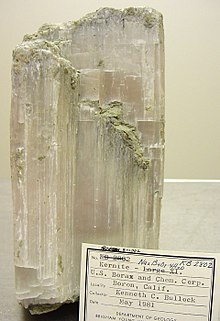
Back كيرنيت Arabic Керніт Byelorussian Kernita Catalan Kernit Czech Kernit German Kernita Spanish Kernita Basque کرنیت Persian Kernite French Kernita Galician
| Kernite | |
|---|---|
 | |
| General | |
| Category | Inoborates |
| Formula (repeating unit) | Na 2B 4O 6(OH) 2·3H 2O |
| IMA symbol | Ker[1] |
| Strunz classification | 6.DB.05 |
| Crystal system | Monoclinic |
| Crystal class | Prismatic (2/m) (same H-M symbol) |
| Space group | P21/c |
| Unit cell | a = 7.0172(2) b = 9.1582(2) c = 15.6774(5) [Å] β = 108.861(2)°; Z = 4 |
| Identification | |
| Formula mass | 273.22 g/mol |
| Color | Colorless, white |
| Crystal habit | Crystalline - occurs as well-formed coarse sized crystals |
| Cleavage | Perfect on [100] and [001], good on [201] |
| Fracture | Splintery |
| Tenacity | Brittle |
| Mohs scale hardness | 2.5-3 |
| Luster | Vitreous - pearly |
| Streak | White |
| Specific gravity | 1.9 - 1.92 |
| Optical properties | Biaxial (-) |
| Refractive index | nα=1.454, nβ=1.472, nγ=1.488 |
| Birefringence | δ =0.0340 |
| 2V angle | 80° |
| Other characteristics | Non-radioactive, non-fluorescent, non-magnetic |
| References | [2][3][4] |
Kernite, also known as rasorite, is a hydrated sodium borate hydroxide mineral with formula Na
2B
4O
6(OH)
2·3H
2O. It is a colorless to white mineral crystallizing in the monoclinic crystal system typically occurring as prismatic to acicular crystals or granular masses. It is relatively soft with Mohs hardness of 2.5 to 3 and light with a specific gravity of 1.91. It exhibits perfect cleavage and a brittle fracture.
Kernite is soluble in cold water and alters to tincalconite when it dehydrates. It undergoes a non-reversible alteration to metakernite (Na
2B
4O
7·5H
2O) when heated to above 100 °C.[3]
- ^ Warr, L.N. (2021). "IMA–CNMNC approved mineral symbols". Mineralogical Magazine. 85 (3): 291–320. Bibcode:2021MinM...85..291W. doi:10.1180/mgm.2021.43. S2CID 235729616.
- ^ Kernite WebMineral
- ^ a b Handbook of Mineralogy
- ^ Kernite on Mindat.org